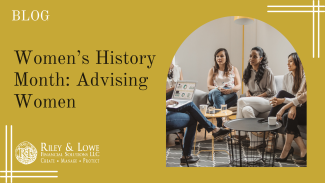
Women’s History Month: Advising Women
Financial professionals need to address the special financial concerns of women
Women’s History Month has its origins as a national celebration in 1981 when Congress passed and authorized a resolution and requested the President to proclaim the week beginning March 7, 1982 as “Women’s History Week.” Throughout the next five years, Congress continued to pass joint resolutions designating a week in March as “Women’s History Week.”
In 1987 after being petitioned by the National Women’s History Project, Congress passed a new resolution designating the month of March as “Women’s History Month.” Since that time, Congress and presidents have issued a series of annual resolutions and proclamations designating the month of March as “Women’s History Month.”
These proclamations celebrate the contributions women have made to the United States and recognize the specific achievements women have made over the course of American history in a variety of fields.
Women Want Real Conversations
Women have special concerns about financial independence that financial professionals need to address. For one thing, they tend to live longer than men, so they need to worry about paying for an extended old age.
The data that follows is pertinent to the conversations that financial professionals should have with female clients, recognizing that the challenges women face are significant.
- Women comprise 51% of the U.S. population and roughly 65% of the workforce.
- Women are the sole heads of 32% of American households.
- Approximately 60% of college students are female.
- Women control 65% of global spending and more than 80% of U.S. spending.
Women are holistic when it comes to buying decisions. They want to ask questions and be asked questions; they want a real conversation; and they want to be educated.
Women worry about financial independence. And most consider health a major risk to their financial future. They also worry about the death of their spouse as a major risk. And often the disability insurance is lacking or inadequate, and life insurance will not deliver sufficient financial horsepower if the breadwinner dies. Further, a surprising number of parents, single and married, do not have wills and have not provided for their children.
The #1 Issue
There are lots of studies that say that the number one retirement issue for women is the threat of poverty. Of people age 85 and older, 71% are women, and the median income for older women is under $17,000 and only 53% of that of older men.
Early in the planning game, women need to focus on retirement income-building vehicles, insurance on spouses, Social Security strategies, estate planning and financial confidence.
The #2 Issue
Caregiving is often the number two issue. Of unpaid caregivers, 57% are caring for parents, and over 70% of caregivers are women.
Further, when women assume caregiver roles, they are 2.5 times as likely to end up in poverty as non-caregivers – and single caregivers are four times more likely to end up in poverty than married women.
Families should discuss financial independence, for both the baby boomers and their parents. Understanding the ins and outs of long-term care insurance is important in the planning process.
The #3 Issue
Divorce is often the number three issue, as women recognize that divorce derails retirement. Not everyone knows that a pension earned during marriage is a joint asset. And there is real temptation to go for assets of a higher present-day value, but securing the right to future retirement income could mean the difference between a comfortable retirement or teetering on the edge of poverty.
Social Security accounts for about half of all income for unmarried women 65 and older, including those widowed, divorced or never married. Deciding when a person takes Social Security makes a difference in retirement security. Waiting until full retirement age (there are ranges depending on when you were born) makes a huge difference.
It Starts with a Conversation
Boomers and their parents – men and women – seek solutions to the real-life challenges of aging. Women, who know that the odds of being alone in old age are significant, want help in navigating longevity. They want financial and psychological confidence.
It all starts with a conversation, followed by living an on-going holistic plan.
Important Disclosures
The opinions voiced in this material are for general information only and are not intended to provide specific advice or recommendations for any individual.
All information is believed to be from reliable sources; however LPL Financial makes no representation as to its completeness or accuracy.
This article was prepared by FMeX.
LPL Tracking #1-05252821

